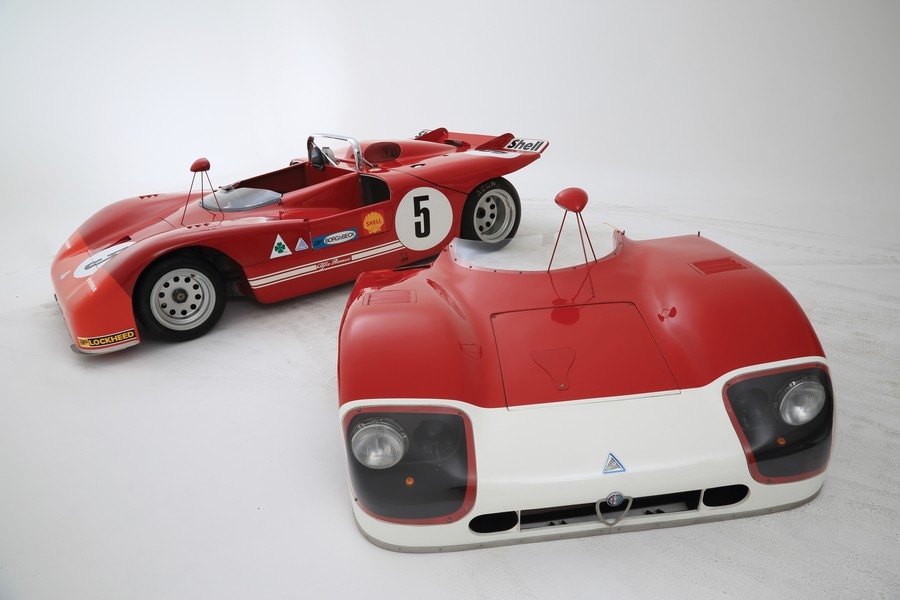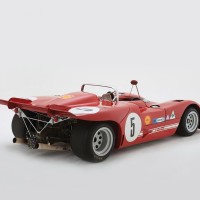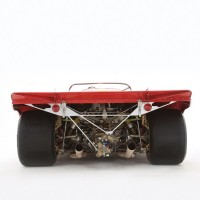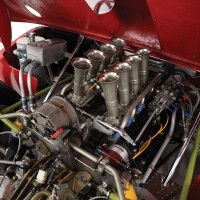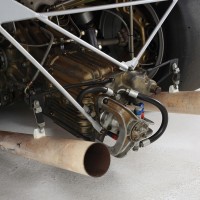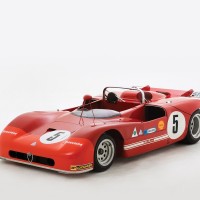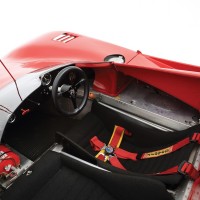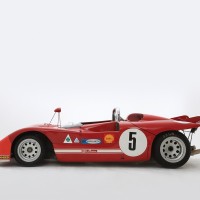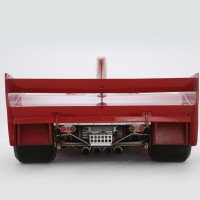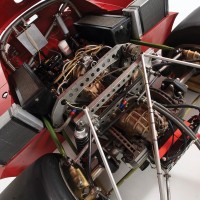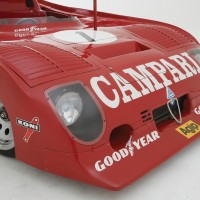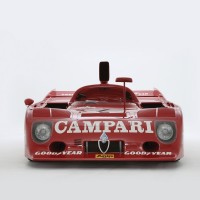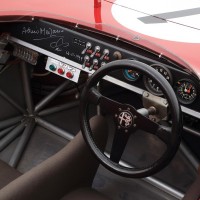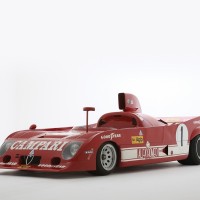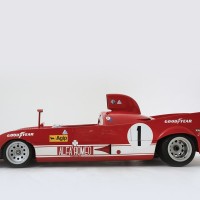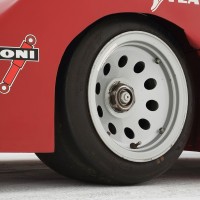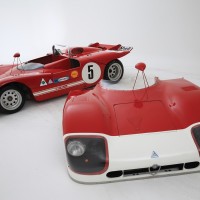SCM Analysis
Detailing
| Vehicle: | 1975 Alfa Romeo Tipo 33/TT/12 |
| Number Produced: | 8 |
| Original List Price: | N/A |
| Chassis Number Location: | Unknown |
| Engine Number Location: | Unknown |
| Club Info: | Alfa Romeo Owners Club |
| Website: | http://www.aroc-usa.org |
| Alternatives: | Ferrari 312 PB, Porsche 908, Matra 650 |
| Investment Grade: | A |
The whole T 33 saga started in 1966. Alfa Romeo had been riding high for a number of years, selling their Type 105 Giulia production cars very successfully, and racing their TZ and TZ2 in the FIA Sports category as well as their Giulia GTA (model type 105.32) in the non-FIA points European Touring Championship. For the 1966–71 period, the FIA had moved the highly prestigious Manufacturers Championship to the Prototype class with breaks at 1,300 cc, 2 Liters, and Over 2 Liters. Ford and Ferrari were dominating the big class in their war for supremacy, but Porsche was pretty much alone in the 2-liter group with the Porsche 906. Alfa sensed the opportunity to go after the mid-bore Manufacturers Championship with only Porsche to compete against.
With this in mind, Alfa and their racing subsidiary, Autodelta, designed a 2-liter V8-powered sports racing “prototype” to match the 906. Since it was the next project after the 105.32-designated GTA, it became the 105.33 — or Type 33. As we will see, the concept evolved almost unrecognizably over the next 10 years, but the prototype sports racing cars always maintained the T 33 designation.
A killer rule change
The first cars, designated simply T 33 and nicknamed “Periscopo” because of the tall central engine intake scoop, debuted at Sebring in early 1967. They were designed by Carlo Chiti and utilized a unique — some would say bizarre — “catamaran” frame that used two very large-diameter cast-magnesium frame tubes that contained the fuel cells. This design allowed for a very even weight distribution at different fuel loads.
However, the new V8 was not well developed and made its power over a very narrow, very high RPM range, which required a 6-speed transaxle. Although occasionally fast, the cars were heavy and unreliable in their first season. Porsche had introduced the 910 and completely dominated 1967, while Alfa tried to refine and debug their new racer.
The killer for Alfa Romeo was that in the middle of the 1967 season, the FIA suddenly and arbitrarily abandoned the old three-class championship in favor of a single championship for 3-liter cars. The result was that for 1968, Alfa was stuck bringing a 2-liter knife to a 3-liter gunfight. To add insult to injury, the Group 4 sports cars (5-liter, 50-car production, such as the Ford GT40 and Lola T 70) were allowed to compete for the championship as well, so even a developed 2-liter didn’t have a chance. Alfa struggled through the 1968 season and introduced the extensively redesigned, faster, and more reliable T 33/2, but it was too small, too late. Porsche had brought out the 3-liter 907 and 908 racers and fought Ford’s GT40 for the championship, with Alfa a distant third.
Enter the T 33/3 in 1969
For 1969, Alfa felt that it had no choice but to graduate to 3 liters, so they introduced the T 33/3. It was a new, titanium-reinforced sheet steel “sort-of monocoque” chassis powered with an all-new 3-liter V8. Alfa started all over again in the development process, ironically just when they’d finally gotten the T 33/2 to work right.
It was a truly miserable season for Alfa, with teething and reliability problems embarrassing the new T 33/3 while Porsche’s 908 and Ford’s GT40 ran away from them. Later in the season, they simply abandoned the 3-liter cars and went back to the 33/2 while they tried to fix the problems.
A great weapon, but outgunned
When the 1970 season dawned, Alfa was ready. They had gotten the 3-liter V8 to make lots of reliable horsepower, they had the chassis design working and the aerodynamics right. In short, they were ready.
Unfortunately, this was the year that Porsche used the loophole and made the 5-liter 917 work while Ferrari fielded its 512 to do battle. No 3-liter car had a chance against these monsters, so Alfa again languished in the background.
The same deal applied to 1971, but there was light on the horizon, as the 5-liter exemption was ending for 1972, so the battle would finally be fought in 3-liter cars. In anticipation Ferrari more or less ceded the field to Porsche, letting privateers run the 512M while they concentrated on the new 312 PB for 1972.
Late in the 1971 season, Alfa brought out their new weapon for the next year, the T 33/TT/3 (Telaio Tubolare, or tube frame), the idea being to use the last of a lost season to be really ready for the glory year to come. It was a very different car than before: The chassis was shorter and lighter, the transaxle was moved forward of the differential to better center the weight, the driver sat way forward with his feet in front of the front wheels, it used 13-inch wheels and the engine now made 440 horsepower — and they got the handling down.
Alfa was truly ready for the 1972 racing season.
Unfortunately, so was Ferrari. The 312 PB was for all intents and purposes a 3-liter Formula One car with room for a second seat. It was light, incredibly complicated and insanely fast — if not as robust or as desirable for the series of endurance races that comprised the Manufacturers Championship series. Ferrari adapted to this by building two sets of three cars, allowing them to “leapfrog” races with one set being prepared while the other raced alternate events.
Ferrari also chose not to run the 24 Hours of Le Mans race rather than risk breaking. Ferrari utterly dominated 1972, even though Alfa had a very good car.
The T 33/TT/12
To match Ferrari’s 312 PB, Alfa created the T 33/TT/12 for 1973. It was another big step — both to a new engine and a revised chassis — with all of the new engine reliability issues cropping up in a now-too-heavy chassis.
Ferrari, having convincingly made its point in 1972, basically went home, but now the French Matras were getting their issues resolved, so Alfa struggled through another development year while Matra won everything.
1974 should have been Alfa’s year, but it wasn’t to be. They had finally gotten the TT/12 really working, but the oil embargo killed interest in racing. Nobody (particularly Alfa) had any money, and what interest there was seemed to be moving to production racers, such as Porsche’s RSR. It was another miserable year for Alfa, and Matra won again.
In anticipation of 1975, Alfa revised the TT 12, moving the transaxle behind the rear wheels for better balance and making other detail changes to make the car truly competitive. However, the money situation was so grim that when the time came Alfa simply pulled the plug on racing, as they just couldn’t afford it. At the darkest hour, along came an Austrian businessman named Willi Kauhsen, who effectively bought the team for the season.
Alfa was ready in 1975, but it was a terrible year for auto racing in general — and particularly for the out-of-fashion sports racing prototypes. Still, 1975 was finally Alfa’s year: They won everything with the T 33/TT/12 racers (in honesty, there wasn’t much competition). Alfa finally won the elusive Marque Championship, but it had ceased to mean much, as the world had moved on.
Great cars that need help
All this history doesn’t leave a lot of space for discussing our subject cars. It is probably best to observe that they are excellent examples of two of the three times in the history of the model that Alfa actually got things right (the third was the 1972 T 33/TT/3 that I profiled in the March 2012 SCM on p. 56).
The 1970 T 33/3 was an excellent, well-developed middleweight that found itself in the ring against probably the best heavyweights in motor-racing history, so it never had a chance to win. The T 33/TT/12 was the ultimate iteration of the T 33 series and won the World Championship for Alfa, but the spotlight had moved to production-based cars, so few noticed.
Alfa T 33s have become highly collectible over the past years, but there is great complexity in setting values. Why? Well, Alfa never built more than a few of any one of the variants — and few parts are interchangeable, even between engines — so value for a given car is very much a function of whether it is an actively running car with spares packages and so on.
My contacts at the auction tell me that both cars had obviously not run in awhile and would probably need substantial investment before they did, which would explain why they were valued at such a discount to the apparently excellent 33/TT/3 that sold for $946,680 in October 2011.
I have found that buyers in this category of racing car tend to be very cold and rational when raising their paddles, so condition and issues would have been factored against a ready-to-race value of about $1 million. I would suggest that both cars, which need a lot of expensive work before rolling onto the track again, were fairly bought. ♦
